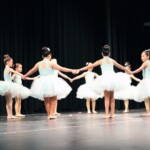The Importance of Pre-pointe Class for the Young Ballerina
Molly Scott
What is “pointe?” It is the epitome of ballet—a technical skill that takes ballerinas from intermediate dancers to advanced. Pointe shoes are a major component of the ballerina image, a vital accessory in the dancing culture, imagined or real. But with great shoes come great responsibility—and that’s why the Omaha School of Music and Dance offers a designated class for young dancers about to advance onto pointe shoes.
Firstly, one needs to know that when referring to “pointe” in dance, it pertains to the foot—particularly the toes and arch. Pointing the feet creates a continuous and elegant line along the whole leg and allows for agility and lightness during routines. To dance “en pointe” (on point) is to stand with weight on the very “tippy-toes” of the foot and do maneuvers from there. Initially, this style of dancing was to allow the ballerinas to float and flit across the stage as if flying (there are many roles for winged fairy folk in classical ballet stories). To do this, a special shoe was developed—the pointe shoe—with a flat toe box and strong structural arch support. This slipper keeps its structural integrity under the weight of the dancer, while providing as much comfort as possible. (Comfort is relative, though, when putting many pounds of dancer onto a very small amount of surface area!)
On pointe, ballet dancers can take maneuvers to another level. Pirouettes transform into a breath-taking marathon of spins with added fouettés for momentum, échappés have a flick and extension difficult to produce on demi-pointe. Not to mention the extension of the legs with the rigid, satin point shoes creates the classical visual aesthetic of the ballet dancer with impossibly long limbs.
Being granted access to pointe shoes from an instructor is a graduation into the very elite and technical realms of ballet. Yes, note that a dancer will need a referral from a teacher to even be fitted for their first pair of pointe shoes. Now a young dancer will decide if they are serious enough to keep dancing through their teens, from intermediate levels into advanced. This is the perfect opportunity to take a dance student aside with the teacher and discuss progressing on to pointe shoes, the realistic expectations, and challenges of doing so. The ballet teachers at the Omaha School of Music and Dance use the Pre-pointe class as an opportunity to evaluate individual students’ skills and commitment to dancing, introduce the shoes, and develop the muscles and discipline to dance safely “en pointe.”
Pre-pointe class is necessary to prepare a dancer’s body for pointe shoes, to break in the shoes, and to learn how to appropriately use them. Pointe shoes require incredible strength throughout the legs, ankles and feet! Special exercises are used to pinpoint the appropriate muscles, so that dancers can ascend onto their toes and descend with control. The majority of the time spent in pre-pointe class is as the barre where this can be practiced slowly and safely with the dance instructor monitoring each student’s progress. For example, the teachers at the Omaha School of Music and Dance look for the strength to balance very well on one leg while elevated in demi-pointe, as well as the flexibility in their feet to point their toes, and to strength of their arch so that a pointed foot continues the line of the shin. Our teachers also divulge tips and tricks of the advanced dancer in these classes, as the shoes add an element of technicality outside the realm of the dance studio alone.
What age is appropriate to consider pre-pointe class? Because of the strength needed to dance on pointe safely, dancers must have at least three to four years of intensive dancing—this usually means they’ve been taking ballet a few more years before that, and are taking ballet classes at least two-three time per week. This is a matter of your child’s safety, and strength-building and endurance are priority Number One. Generally, this puts ballerinas in the 12 year-old age bracket when considering advancing to pointe shoes. Depending on strength, a student might be younger, and they might be older. Dancer’s cartilage is still soft and malleable when they’re young, so starting on pointe at too young an age can cause serious harm to a child’s feet. Instead, it’s best to prioritize proper and healthful technique before cartilage firms up on the cusp of puberty.
So if you have a young ballet dancer 9-10 years old who is looking to commit more time to their art, bring them to the Omaha School of Music and Dance. We would be happy to sign your student up for dance classes where our teachers can assess if they are ready to consider pointe shoes. Register online or call our studio to arrange a tour and sign up for the OSMD’s pre-pointe and pointe classes!



